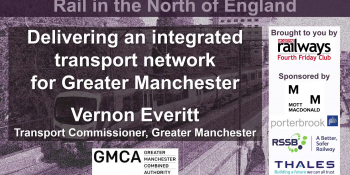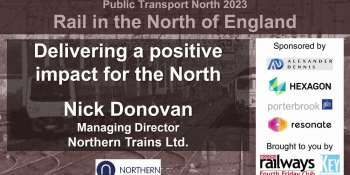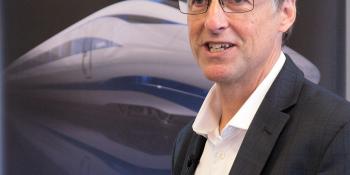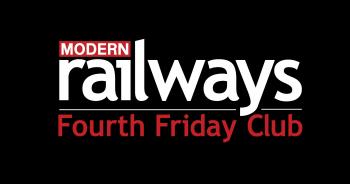
Viewers of our Rail in the North of England conference had the opportunity to submit questions by e-mail for the speakers at our three sessions. Reproduced below are the questions and answers in full.
Question for David Hoggarth:
Thanks for taking the time to present at the Modern Railways event on Friday. There were a number of reassuring messages in your presentation about the gradual maturing of the TfN organisation.
On Smart Ticketing, you seemed to be saying that the current smart card solutions had not been a particular success and that you saw the answer to the change in travel patterns brought about by Covid as requiring a different solution.
You directly mentioned account-based ticketing with a best price/fare/value promise for the journey made. Giving the customer confidence that they would always pay the best value fare.
Do you envisage this being delivered by a Mobile/NFC solution or do you think that an ITSO/EMV solution still provides the best way forward?
Response from David Hoggarth, Strategic Rail Director for Transport for the North:
Our IST programme successfully introduced ITSO smartcards for rail passengers. This has been an important first step in transforming the North’s ticketing offer. Pre-pandemic, by March 2020, we had been successful in converting a majority of eligible season ticketing customers from paper to smart technology – with take-up outperforming other regions.
Furthermore, the installation of ‘tap-in tap-out’ infrastructure – initially for smart cards – was part of a longer journey to transform ticketing and payments on rail, with the potential to in time facilitate mobile and contactless payments too.
Currently, there is no funding allocated for the IST programme beyond March 2021. TfN has been clear on the benefits of an EMV-led solution for pay-as-you-go travel on rail and other modes as a next step to provide increased convenience and flexibility for passengers.
TfN still appreciate the value of existing ITSO infrastructure – on which we have more recently delivered flexi smart seasons in partnership with Northern – as well as Mobile/NFC technology.
We are keen to both make these flexi tickets more widely available, and also explore innovative new ways these technologies could be better connected to deliver account-based ticketing and other travel offers/incentives that would boost customer confidence in post-Covid public transport and drive modal change. Rolling out better value ticketing options as well as new technology is one of the six core elements of TfN's roadmap to recovery from the pandemic.
Question for David Hoggarth:
In your talk to Fourth Friday regarding TfN’s vision for the future rail strategy for the north, the vision which you presented was, as previously, very city focussed and similar to that presented prior to the 2019 General Election. The Election results however drew attention to the ‘left behind towns’ of the region and the Government itself has subsequently responded to this unmet need by initiatives such as the Reversing Beeching Fund, however your presentation did not mention these communities and as to how TfN is to incorporate their aspirations and needs into an updated strategic vision. I also noted that you did not include Merseyrail Electrics in your presentation even though it serves sizeable communities, some of which are ‘left behind’ – the same could be said for the Tyne and Wear Metro. Both of these rail bodies are also innovative in their approaches and benefit from close accountability to their communities and local government, and cover wide areas of the north not just a single city. You also did not mention the Reversing Beeching proposals even though they would be aiming to restore rail service to sizeable towns such as Fleetwood and important links to other left behind towns such as Southport to Preston and Colne to Skipton. So please could you advise me as to how TfN is proposing to incorporate the needs of these left behind towns into its forward thinking and its strategy?
Response from David Hoggarth, Strategic Rail Director for Transport for the North:
Transport for the North is focused on providing the best possible transport connectivity for all the 15.2 million people who live and work in the North of England. This includes those, not just in the larger cities in the North, but those who live in the towns and shires across the whole of the Region. In fact, the Long Term Rail Strategy includes desirable minimum standards of connectivity across the whole classic rail network. These standards look to ensure:
• All passenger routes to be served by a minimum two trains per hour;
• Inter-urban services to achieve average journey speeds of at least 60mph;
• Local and suburban services to achieve average journey speeds of at least 40mph; and
• Direct connectivity between tourist destinations and economic centres in their catchments.
The Strategic Rail Team’s work includes routinely liaising with local authority partners and passenger transport executives on intra-regional and multi-modal connectivity. We are also actively supporting our partners on initiatives such as Beeching reversals where these align with our overall strategy, and are consistent with our objectives. One of the key goals of the organisation is to contribute to the decarbonisation of the British economy, and an essential part of this is encouraging a shift to modes of transport which generate lower carbon emissions.
In particular, we note that localised traffic congestion can have a detrimental impact on local economies, and the treatment of such problems can be transformational to some areas. Mitigating local congestion can thus contribute towards achieving the transformational economic growth and 'levelling up', which is TfN’s primary aspiration.
In terms of the excellent examples of Tyne and Wear Metro and Merseyrail, we work closely with both Nexus and Liverpool City Region and the operating models used by these locally-specified networks are helping inform how we evolve the transport offer further across the North and move from the traditional franchise model to one which is likely to bring track and train closer together under a guiding mind once the outputs of the Williams Review are seen and have bedded in. Our strategy includes all heavy rail networks (using Network Rail infrastructure).
Finally, your point on ‘left behind towns’ such as Southport and others, is not lost on us. As a post-pandemic rail offer evolves, with different travel and commuting patterns, it is vital that the right kind of connectivity is fully supported – and with leisure travel likely to be the sector which recovers quickest, being able to service leisure destinations will be one of many factors which are taken into consideration. We also recognise that other towns offer resources and capabilities which merit their own recognition when transport decisions and interventions are being considered.
So, in summary, I hope it is clear, that Transport for the North is not simply focused on the major projects (although they are critically important to the North’s economic well-being) but is taking am ‘inclusive’ and cosmopolitan approach to enhancing rail connectivity in the North through partnership working and maintaining an open mind.
Question for Robin Gisby:
Do you see an opportunity post-Covid to improve/introduce services to poorly served areas where the track already exists, eg Pontefract – Doncaster, Goole – Leeds, Scunthorpe – Leeds, Hebden Bridge – Huddersfield, Bradford – Halifax, Barnsley – Sheffield?
Response from Robin Gisby, Chief Executive, DfT OLR Holdings Ltd:
We are keen to explore the potential for providing enhanced services for our customers and would welcome engagement with partners to discuss ideas for improvements. At present, there are no firm plans to introduce new services on these routes. Whilst these routes do operate passenger services at specific times of day, we are unable to extend these services currently as these routes are also primarily utilised by freight carriers. Other routes do offer alternatives for passengers. However, we will continue to explore how we can improve services in these areas for our customers.
Question for Robin Gisby:
What is the future of the 'Northern Connect' brand now under OLR?
Response from Robin Gisby, Chief Executive, DfT OLR Holdings Ltd:
The ‘Northern Connect’ initiative was a concept proposed by Arriva, but has yet to be delivered. Since ownership of Northern transferred to the Department for Transport’s Owning Group, DOHL, in March, this initiative has been under review to ensure that the concept meets evolving customer priorities and is the most optimal solution for our customers. We will be able to give further updates to our stakeholders in due course.
Question for David Powell:
The accessibility work you have done is ground breaking for the rail system. Have you shared this work with the RAIB with a view to incorporating the requirement for a sliding step into future rolling stock specifications?
Response from David Powell, Programme Director - Rolling Stock, Liverpool City Region:
Thank you for your question. Our work in improving our network’s platform train interface is pioneering for the UK main line railway but has its origins in the approach that has been taken since the 1980s as light rail has been reintroduced to some of our major conurbations. The rationale in developing our approach has been to deliver improvements to four key features of the railway:
• Safety;
• Accessibility;
• Operational efficiency (dwell time); and
• Customer experience.
Our approach to the platform train interface has drawn considerable attention and we have engaged extensively with industry bodies such as DfT, RSSB and ORR and other public bodies who may procure rail services. We anticipate that interest will continue to be shown and we will remain available to advocate our approach and to provide practical advice on how it could be translated to other parts of the national network.




